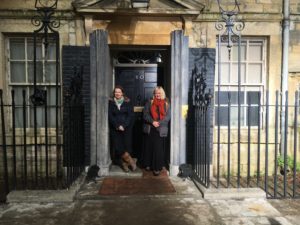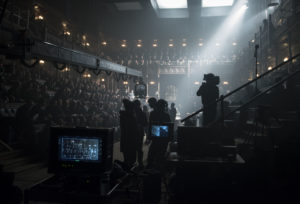
Darkest Hour takes place during the four weeks leading up to the evacuation of Dunkirk, when Winston Churchill (Gary Oldman) took over as Prime Minister of Britain. Sarah Greenwood (Production Designer) and Katie Spencer (Art Director) reunite with director Joe Wright to create the sets reflecting this extremely tense period in WWII history. As Greenwood points out, “We had no idea that we were so close to absolute disaster, that we were hours away from surrendering.”
As Greenwood states, “I love this idea of the story being the underbelly, that it was literally metaphorical. We were underground, and you were seeing this whole story that wasn’t known.” The team built and dressed the sets historically accurate to a point, but the “mood and atmosphere of the time” took precedence. “The way Joe tells a story, it’s got to be real and lived in, not a verbatim historical recreation.”
Much of the film takes place in the basement war room. Part of the original war room, which still exists as a museum in London, provided inspiration for the set. Rather than approach it literally, Greenwood and Wright discussed it being more like a maze, “like in the West Wing where cameras are moving the whole time through rooms.” As Greenwood says, “You never knew where you were, a metaphor” for how Churchill had to navigate all the obstacles politically and physically.

In 1940, they thought they’d be safer running the operation from the basement of the war office, but learned that in the event the building was bombed, the floors above would crash down. So they hired a Naval architect and shipwrights who shored it up. Greenwood’s design reflects the “forest of beams” that supported the floor above, making the set even more maze-like. The brick walls were particularly well done, with different types of brick used to ground it in reality, indicating the different incarnations of the building over time.
The set was built “over two huge stages,” according to Spencer, and they had to be prepared to fly walls. “You could be down there for 12 hours and never even know what the weather was.” So they made wooden signs that said “windy or raining, and that was all you got.” The set dressing and props included a lot of graphics. “We had to make all the maps and everything like that,” all within the confines of the budget. The House of Commons set, also built on a stage, was another budgetary challenge for the design team.
“The Nazis, who were a war machine, had pin sharp, organized plans. The desks were all the same.” England had to pull together resources to fight the Nazis. “Everything we had was cobbled together,” says Spencer. Her decorating choices, such as mismatched chairs, were done to convey this idea visually.
Wright and Greenwood did not want to shoot at the typical stock locations in London for Buckingham Palace, so they found derelict houses, giving them total control, as the standard locations have many restrictions. The Buckingham Palace scenes were shot in the North of England at Lancaster House, which had a “tragic life of its own. It had a beautiful shell; the bones were there.” Originally the great room had a life-size painting of the famous horse Whistle Jack by George Stubbs, but the owners had to sell it, so Greenwood’s painters recreated it for them. The original painting is currently housed in the National Gallery.
10 Downing Street was similarly built in a derelict house, as you’re not allowed to touch anything in the real location, making it difficult to bring in a film crew. Interestingly, the actual Downing Street entrance hall does not include a stairway, “but nobody knows that, and it worked for our story,” according to Greenwood. The scene where King George visits Churchill is at a point in the film when Churchill “reaches rock bottom, like he’s hiding.” They used an attic room in the derelict house that had peeling wallpaper to reflect Churchill’s state of mind. “In no way would he have ever received a king in that room, but as far as the storytelling, it had the right kind of atmosphere and mood.”
Greenwood and Spencer “work with a fantastic team of people,” including the construction team and on-set art crew, to realize their designs. As Spencer exclaims, “You’re only as good as the team you work with, and I work with you (meaning Greenwood), and you’re pretty good!” Greenwood replies, “If you’re not having fun, then don’t do it, because it’s too much like hard work. So we certainly have fun when we do it!”





